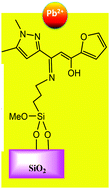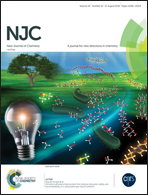Engineering β-ketoenol structure functionality in hybrid silica as excellent adsorbent material for removal of heavy metals from water†
Abstract
Chelating adsorbents, based on the chemical modification of silica by an efficient host able to capture toxic metals, are the most popular materials for wastewater treatment. Herein, a novel inorganic–organic hybrid material incorporating a β-keto–enol bis-heterocycle structure (SiNPz-Fn) was synthesized and the structure of the host was confirmed by single crystal X-ray diffraction. This ligand was designed to introduce active lone-pair donor systems on the silica surface. The new material has been characterized using a set of suitable physical techniques, and was found to be an efficient adsorbent for Pb(II), Zn(II), Cu(II) and Cd(II) from aqueous solution. The influence of the solution pH, contact time, initial concentration, temperature, thermodynamics and co-existing interferent substances was also studied. The adsorption kinetics of Pb(II), Zn(II), Cu(II) and Cd(II) onto SiNPz-Fn can be well fitted with a pseudo-second-order model and the adsorption capacity of this material is evaluated as 87.71, 54.64, 28.81 and 10.77 mg g−1 for Pb(II), Zn(II), Cu(II) and Cd(II), respectively. An endothermic and spontaneous process was identified. The new material was used for the extraction of metals from natural water and promises good recyclability for at least five cycles, showing great potential in practical applications.



 Please wait while we load your content...
Please wait while we load your content...